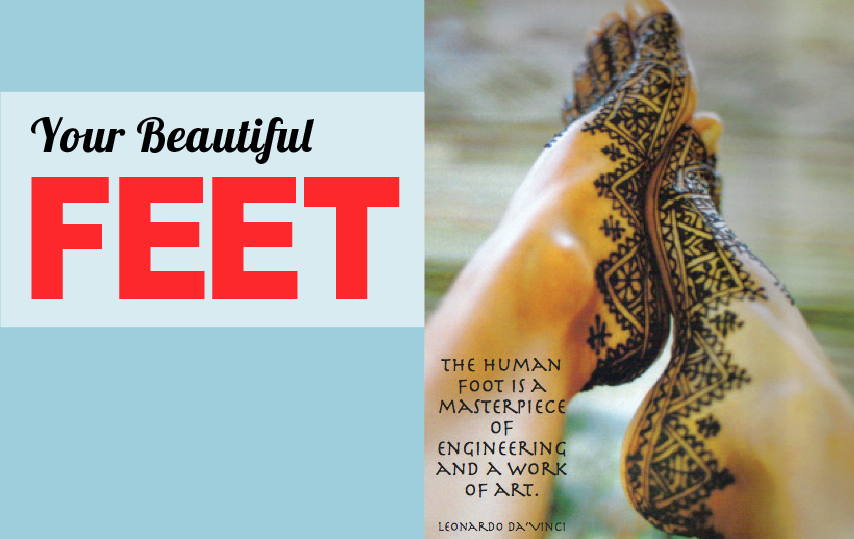When I started selling sandals in Hawaii, I discovered there were many people walking around with feet problems. My customers were reluctant to try something new and claimed that anything they wore aggravated their plantar fasciitis. Others agonized over painful arches or regretted that their toes – confined for years to tight and narrow hard-toe shoes – had curled and morphed into knobby-looking stumps. Often they were embarrassed to take off their shoes and I never heard a customer express love for their beautiful feet.
It took empathy and imagination for me to understand their issues as I’ve never had foot problems. I’ve endured sprained ankles while playing sports, and like others I’ve stubbed my toes, but real foot issues are outside my experience. And when I started yoga at about the same time I began selling sandals, I saw the critical connection between foot comfort and standing asana challenges related to foot stability. It was easy to see the importance of feet and their foundational role in healthy living.
Some of my yoga instructors regularly take time at the beginning of class to talk about grounding one’s feet to the mat as a way of grounding in the here and now. They ask us to sway from toes to heel and remind us that yoga class only takes a small slice of time and happens on the small space of a mat, but the grounding of feet as a way to start practice improves foot circulation, brings us to the present, and improves connections to the place we stand.
Sometimes we’re directed to press up on our toes to improve toe strength and flexibility, but this move also reminds us that we’re preparing to get up on our toes to meet the yoga challenge.
My feet, and yours, are the connection points to our yoga mats and the earth. We propel ourselves forward into the world on our feet. And some say when we take a strong position on something we’re taking a stand. In metaphor, and in real life, we start the forward journey into life on our feet.
Feet are viewed in various ways around the world. Some cultures view feet, and especially the soles, negatively. They connect the foot and sole to the lower levels of life and see it as a dirty part of the body. In some places, it’s possible to silently insult someone by aiming the foot-sole toward them.
On the other end of the spectrum, washing the feet of a stranger is seen in some religious communities as a symbol of the ultimate in humility and servanthood. Pope Francis recently shocked many people when he washed the feet of strangers. And in that faith tradition, the New Testament says that those who bring Gospel or good news to the poor have beautiful feet.
This is why all yogis have beautiful feet; they bring good news. It’s not good news in the sense of Christian Gospel, but seeing our feet as beautiful is the place to start a full make-over. This make-over is not cosmetic but foundational.
Yogis learn to exercise their toes and become more aware that feet are the key to forward movement or standing balance. Yogis work to deliberately strengthen the bouncy castle for sale midfoot that forms the arch from 5 irregularly shaped tarsals. The result of all this yogic attention to their standing base is life-long health and pain free living in our feet – one of the most overlooked and yet important parts of our physicality.
Before even considering the complicated bone makeup of the foot’s arch, or the many small bones forming tarsals and metatarsals, remember that once Leonardo DaVinci said, “The foot is a masterpiece of engineering and a work of art.”
The foot contains 25 percent of the bones in the human body. Additionally, it’s packed with 33 joints and over 100 muscles, tendons, and ligaments; it also holds a critical network of blood vessels, nerves, and soft tissues. It’s not surprising that many people have foot problems, and challenges. The good news is that yoga practice can heal and strengthen weakened feet.
Recently, I was speaking to a yoga newcomer and she said her arch really hurt as she first started doing standing balances. In her life, she’d purposely chosen high-arch shoes to support her back. It’s what she was told to do. But she said yoga has strengthened her arch and her stability has improved in standing asanas. She said she thinks it’s because of yoga has strengthened her feet leading to better overall support and flexibility.
This is good news. And each time someone leads us to see our feet as beautiful works of art, and marvels of engineering it’s not only good news. It’s also yogi gospel.
References:
Simblet, S., & Davis, J. (2001). Anatomy for the artist. New York: DK Pub.
www.healthcommunities.com/foot-anatomy. Retrieved 6/12/16


















 Other
Other